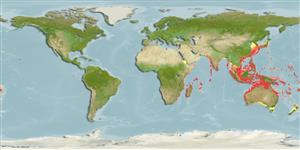>
Eupercaria/misc (Various families in series Eupercaria) >
Priacanthidae (Bigeyes or catalufas)
Etymology: Pristigenys: Greek, pristis = saw + Greek, genys, -yos = face (Ref. 45335).
More on author: Cuvier.
Environment: milieu / climate zone / depth range / distribution range
Ecologie
marien rifbewoner; diepte 1 - 250 m (Ref. 100719), usually 5 - 30 m (Ref. 94109). Tropical
Western Pacific: Japan, East China Sea Shelf, Taiwan, South China Sea, Vietnam, Celebes, Australia, and Indonesia.
Grootte / Gewicht / Leeftijd
Maturity: Lm ? range ? - ? cm
Max length : 27.4 cm SL mannelijk / geslacht onbekend; (Ref. 5403)
Dorsale stekels (totaal) : 10; Dorsale zachte stralen (totaal) : 11; Anale stekels: 3; Anale zachte stralen: 10; Wervels: 23. This species is distinguished from its congeners by the following set of characters: D X,11; A III,10; total gill rakers on first arch 27-31, mode 27 (upper limb 7-10, lower 19-22); lateral-line scales 31-39, mode 35; body scales above pectoral fin with about 11-60 spinules on posterior margin, the number increasing with growth; generally rounded caudal fin in young, becoming somewhat double emarginate in adults (noticeable in specimens over 15.0 cm SL); absence of black margins on posterior soft portions of vertical fins; 5 white or pale vertical bands (often indistinct) on body about 1/2-3/5 width of pupil expanded ventrally and dorsally with latter angled posterodorsally, very notable in young, less obvious in adults (Ref. 94109).
Associated with rocky habitats and known from 80 to more than 100 m depth but probably also occurring in shallower water, especially as juveniles (Ref.5403). From dive observations, juveniles and young individuals likely occur at 5-30 m depths (Ref. 94109). Eggs are pelagic (0.75 mm), small and spherical.
Levenscyclus en paargedrag
Maturities | Voortplanting | Spawnings | Egg(s) | Fecundities | Larven
Iwatsuki, Y., T. Matsuda, W.C. Starnes, T. Nakabo and T. Yoshino, 2012. A valid priacanthid species, Pristigenys refulgens (Valenciennes 1862), and a redescription of P. niphonia (Cuvier in Cuvier & Valenciennes 1829) in the Indo-West Pacific (Perciformes: Priacanthidae). Zootaxa 3206:41-57. (Ref. 94109)
Status op de Rode Lijst van het IUCN (Ref. 130435)
Gevaar voor de mens
Harmless
Gebruik door de mens
Visserij: commercieel
Tools
Speciale rapporten
Download XML
Internetbronnen
Estimates based on models
Preferred temperature (Ref.
123201): 20.8 - 28.9, mean 27.6 °C (based on 972 cells).
Fylogenetische diversiteitsindex (Ref.
82804): PD
50 = 0.5313 [Uniqueness, from 0.5 = low to 2.0 = high].
Bayesian length-weight: a=0.02239 (0.00929 - 0.05398), b=2.93 (2.73 - 3.13), in cm total length, based on LWR estimates for this (Sub)family-body shape (Ref.
93245).
Trofisch niveau (Ref.
69278): 3.9 ±0.5 se; based on size and trophs of closest relatives
Weerstandsvermogen (Ref.
120179): Hoog, minimale populatieverdubbelingstijd minder dan 15 maanden (Preliminary K or Fecundity.).
Fishing Vulnerability (Ref.
59153): Low vulnerability (23 of 100).
Nutrients (Ref.
124155): Calcium = 59 [29, 100] mg/100g; Iron = 0.642 [0.372, 1.050] mg/100g; Protein = 18.8 [17.6, 20.0] %; Omega3 = 0.143 [0.085, 0.240] g/100g; Selenium = 47.3 [25.9, 86.6] μg/100g; VitaminA = 48.2 [13.8, 166.8] μg/100g; Zinc = 0.988 [0.669, 1.420] mg/100g (wet weight);
